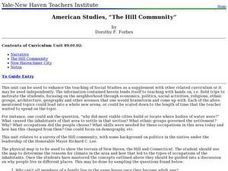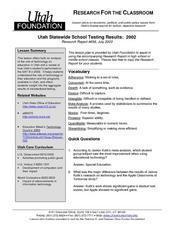Curated OER
Priorities and Power: Migrants and Voting
Students examine the African-American migrants entry into the political process. They summarize their findings in a short essay.
Curated OER
Creating Communities
Pupils design a community with minimal environmental impact. They rate each other's community's presentation using the "Planning and Zoning Commission Rating Scale".
Curated OER
Town Development
Students use a map of Kansas in the 1800s to discuss town development and issues related to slavery. They create fictitious towns to promote to outsiders.
Curated OER
Good Brother, Bad Brother
Students are exposed to the writings of John Wilkes Booth. They discover that fanaticism is not just a modern phenomenon. They examine four periods in American history when treason was at issue.
Curated OER
When in Greece, Do as the Greeks Do
Students examine the contributions of ancient Greeks in this five lesson unit. The explorations reveal how Greece shaped our stories, our modern language, and our society. The study of the Greek myth forms the basis of this unit.
Curated OER
Arkansas Counties
Young scholars identify and locate various Arkansas counties which surround their home, and research the various counties in order to create a group presentation.
Curated OER
Fertilization and Pregnancy
Middle schoolers use a KWL chart and describe their knowledge of fertilization, pregnancy and birth. They watch a video of fertilization and development and create a poem, song or dance about what they have learned.
Curated OER
Where's the Barbecue?
Students identify the major landforms, regions and rivers on a map of South Carolina. They compare the locations of the major Native American groups in the state as well. They chart where barbecue restaurants are located and write...
Curated OER
Centennial: Secrets From Beyond...
Fourth graders identify cemeteries as a source of information for historical research. They consider the types of information cemeteries can provide, review local headstones and create a database of the collected knowledge.
Curated OER
Centennial: Simple Gifts...Personal Contributions To Utah
Fourth graders consider how the concept of giving can affect a society for the better. They read various essays on giving and examine obituaries to highlight individuals who contributed to society over the course of their lives.
Curated OER
Ticket to Ride
Learners research a place they would like to visit. They write a report about that location that includes a map, the climate and other features that explain their desire to visit.
Curated OER
Landfill Lounge
Students accurately construct a model of a sanitary landfill and identify the parts of the landfill and explain their function. They work in grous using a clear plastic box, modeling clay, soil and a variety of garbage to create their...
Curated OER
Japan and Art
Students discuss the art of Japan as it relates to Japanese culture and geography and then create individual postcards reflecting the information learned from the instructional activity. This instructional activity includes possible...
Curated OER
Ukiyo-e
Students investigate and examine ukiyo-e, or Japanese woodblock prints, from the Edo period (1615-1868) in Japan and use this gained knowledge to compare Japanese culture to American societal trends.
Curated OER
A Study of Cross-Cultural Connections
Ninth graders analyze connections between Asia and Europe in the pre-Renaissance period. They identify and analyze elements of Japanese and Chinese culture similiar to that of feudal Europe.
Curated OER
A New, Capital Idea#141
Students design a pamphlet which explains where a capital for a new country, which is comprised of the New England region, should be located. They include the reasons for their decision based on where physical and human features are...
Curated OER
Social Studies: The Connecticut Hill Community
Students discover the reasons for the settlement of the Connecticut Hill Community. Through an examination of the climate, occupations of the inhabitants, and demographics, they discuss reasons people choose locations for settlement. ...
Curated OER
Why Do You Live Where You Do?
Eighth graders identify reasons why settlers bought land from the railroad and not a Homestead grant. Using that information, they compare and contrast the types of land given in each situation. They discuss the reasons why given...
Curated OER
The Study of the Spanish-Speaking People of Texas: Pictures, Images, and Photographs
Students examine how art is used to make statements about social conditions. They analyze photos by the photojournalist Russell Lee, and complete a worksheet.
Curated OER
Utah Statewide School Testing Results: 2002
Students investigate the statewide school test scores for the year of 2002 in Utah. They use critical thinking skills to analyze the results. The target of the lesson is to measure the effect of using instructional technology in the...
Curated OER
Journey Through Time
Young scholars examine the movement of the Bison over the land bridge. In groups, they use the events to put them into the correct sequence. They apply measurement to chronological time and read more information about the land bridge.
Curated OER
Bison Calculations
Students discuss how animals are cared for when they are captured. Using calculations, they determine how much food and water it takes for one bison and compare their water intake to humans. They also compare their weight to that of a...
Curated OER
What is a Ruminant?
Students examine the way bison eat and digest their food. Using a diagram, they follow the food from one compartment to the next. They discover that bison are ruminants and discuss why the bison need four stomachs.
Curated OER
Bison Sites of Texas
Students locate bison-related sites on a map and identify important bison-related sites. The Bison has had a profound effect on the history of Texas and studenst discover the importance of the animal to the history of the state.
Other popular searches
- Local City Government
- City Government in Virginia
- New York City Government
- Baltimore City Government
- Kentucky City Government
- Mayors and City Government
- Writing City Government
- City Government Architecture
- Problems in City Government
- Los Angeles City Government

























